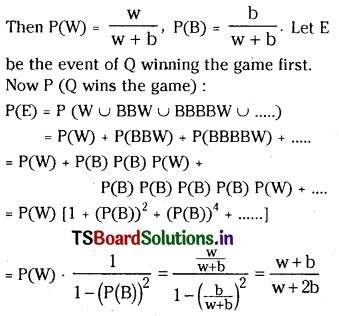Students must practice these TS Inter 2nd Year Maths 2A Important Questions Chapter 9 Probability to help strengthen their preparations for exams.
TS Inter 2nd Year Maths 2A Probability Important Questions
Question 1.
A Number x is drawn arbitrarily from the set [1, 2, 3 ……………. 100]. Find the probability that \(\left(x+\frac{100}{x}\right)>29\)
Solution:
The total points of the sample space are 100.
Let A be the event that an x selected (drawn) at random from the set
S = {1, 2, 3 …………… 100} has the property.
\(\left(x+\frac{100}{x}\right)>29\)
Now x +\(\frac{100}{x}\) > 29 ⇔ x2 – 29x + 100 >0
(x – 4)(x – 25) > 0 ⇔ x >25 or x< 4
Since x ∈ S. it follows that
A = {1,2,3,26.27. ……………………. 100}
Thus the numbers of cases favourable to A is 78.
∴ The required probability: \(\frac{1}{18}\)
P(A)=\(\frac{78}{100}\)=0.78
![]()
Question 2.
Two squares are chosen at random on a chess board. Show that the probability that they have a side in common is \(\frac{1}{18}\).
Solution:
The number of ways of choosing the first square is 64 and that of the second is 63. Therefore the number of ways of choosing the first and the second square is 64 x 63. Let E be the event that these squares have a side in common. We shall find the number of cases favourable to E. If the first square happens to be one of the squares in the four corners of the chess hoard. the second square (with common side) can be chosen in 2 ways.
lf the first square happens to be any one of the remaining 24 squares along the four sides of the chess board other than the corner, the second square can be chosen in 3 ways. If the first square happens to be any one of the remaining 36 Inner squares, then the second square can he choose in 4 ways. Hence the number of cases favourable to E
Is (4 x 2) + (24 x 3) + (36 x 4) = 224
Therefore the required probability is
\(\frac{224}{64 \times 63}=\frac{1}{18}\)
Question 3.
A fair coin is tossed 200 times. Find the probability of getting a head an odd number of time.
Solution:
The total number of points in the sample space is 2200. Let E be event getting a head an odd number of times. Then the number of cases favourable to E is
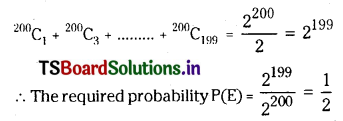
Question 4.
A and B are among 20 persons who sit at random along a round table. Find the probability that there are any six persons between A and B.
Solution:
Let A occupy any seat at the round table.
Then there are 19 seats left for B. But if six persons are to be seated between A and B, then B has only two ways to sit. Thus the required probability is \(\frac{2}{19}\).
![]()
Question 5.
Out of 30 consecutive Integers, two integers are (Irawil at random. Find the probability that their sum is odd.
Solution:
The total number of ways of choosing 2 integers out of 30 is 30C2. Out of the 30 numbers, 15 are even and 15 are odd. If the sum of the two numbers is to be odd, one should be even and the other odd. Hence the number of cases favourable to the required event is 15C1 x 15C1
∴ The required probability

Question 6.
Out of 1,00,000 new born babies, 77,181 survived till the age of 20. Find the probability that a new born baby survives till 20 year of age.
Solution:
Here m = 77,181; n = 1,00,000
Required Probability = \(\frac{77,181}{1,00,000} \) = 0.77181
Question 7.
Find the probability of throwing a total score of 7 with 2 dice.
Solution:
The sample space S of this experiment is given by
S = {(1, 1), (1, 2),…………………, (1, 6),
(2, 2), (2, 2),…………………, (2, 6).
(6, 1), (6, 2),…………………, (6, 6)}
In a typical element, the first coordinate represents the score on the first die and the second coordinate represents the score on the second die. There are 36 points in S and all the points are equally likely. Let E be the event of getting a total score of 7. Then E has the following 6 elements.
{(1, 6), (2, 5), (3, 4), (4, 3), (5, 2),(6, 1)}
∴ P(E) = \(\frac{6}{36}=\frac{1}{6}\)
Question 8.
Find the probability of obtaining two tails and one head when 3 coins are tossed.
Solution:
For this experiment of tossing three coins, the sample space can be seen to be
S = {HHH, HHT, HTH, THH, HTT, THT, TTH,TTT}
Let E be the event of obtaining two tails and a head.
Then E = {HTT, THT, TTH}
∴ P(E) = \(\frac{3}{8}\)
![]()
Question 9.
A page is opened at random from a book containing 200 pages. What is the probability fly that the number on the page is a perfect square.
Solution:
The sample space S of the experiment in a question is given by S = {1, 2,3 ……………… 200}, so that the number of points in the sample space n(S) 200. Let E be the event of drawing a page whose number is a perfect square. Then
E = {1, 4, 9 , 196) so that n(E) = 14.
∴ \(\frac{n(E)}{n(S)}=\frac{14}{200}=\frac{7}{100}\)
Question 10.
Find the probability of drawing an Ace or a Spade from a well-shuffled pack of 52 playing cards. A pack of cards contains a total of 52 cards. These 52 cards are divided into 4 sets namely Hearts, Diamonds, Spades and Clubs. Each set consists of 13 cards, namely:
A, 2, 3, 4, 5, 6, 7, 8, 9, 10, J, Q, K
(Here A : Ace, K: King, Q : Queen, J: Jack)
Solution:
Let E1 be the event of drawing a Spade and E2 be the event of drawing an Ace. Observe here that E1, E2 are not mutually exclusive.
Now n(E1) = 13, n(E2) = 4 and n (E1∩E2) = 1
∴ P(E1∪E2) = P(E1) P(E2) – P (E1∩E2)
\(=\frac{13}{52}+\frac{4}{52}-\frac{1}{52}=\frac{16}{52}=\frac{4}{13}\).
Question 11.
If A and B are two events then show that
(i) P(A∩Bc)P(A)-P(A∩B) and (ii) the probability that one of them occurs is given by P(A)+P(B) – 2P(AB).
Solution:
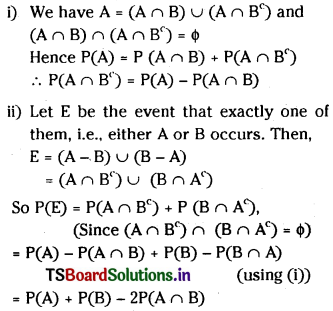
Question 12.
A and B are events with P(A) = 0.5, P(B)=0.4 and P(A∩B)=0.3. find the probability that (i) A does not occur (ii) neither A nor B occurs.
Solution:
(i) We know that Ac denotes the event: A does not occur and (A∪B)c denotes the event: neither A nor B occurs. Then
P(Ac) 1 – P(A) = 1 – 0.5 = 0.5
(ii) By addition theorem
P(A∪B) = P(A) + P(B) – P(A∩B)
= 0.5 + 0.4 – 0.3 = 0.6
∴ P((A∪B)c ) = 1 – P(A∪B)
= 1 – 0.6 = 0.4
![]()
Question 13.
If A, B, C are three events show that
P(A∪B∪C)= P(A)+ P(B)+ P(C) – P(A∩B)-P(B∩C) – P(C∩A)+P(A∩B∩C)
Solution:
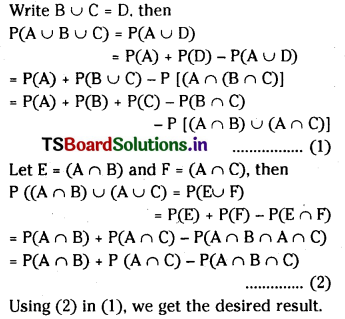
Question 14.
Suppose there are 12 boys and 4 girls in a class. If we choose three children one after another in succession at random, find the probability that all three are boys
Solution:
Let E1 be the event of choosing a male child
In ith trial, I = 1, 2, 3. We have to find P(E1∩E2∩E3).
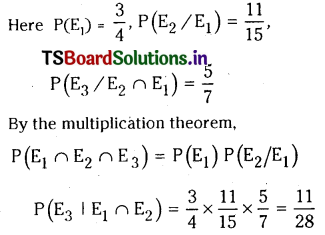
Question 15.
A speaks truth in 75% of the cases and B in 80% cases. What is the probability that their statements about an incident do not match.
Solution:
Let E1, E2 be the events that A and B respectively speak truth about an incident. Then
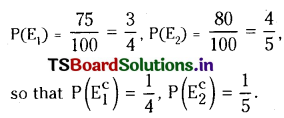
If E be the event that their statements do not match about the incident, then this happens in two mutually exclusive ways:
i) A speaks truth and B tells lie
ii) A tells lie and B speaks truth
These two events can be represented by
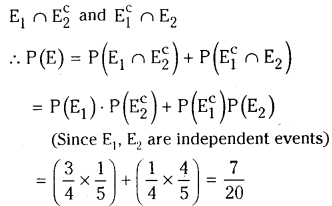
![]()
Question 16.
A problem in Calculus is given to two students A and B whose chances of solving it are \(\frac{1}{3}\) and \(\frac{1}{4}\) respectively. Find the probability of the problem being solved if both of them try independently.
Solution:
Let E1 and E2 denote the events that the problem is solved by A and B respectively.
We are given that P(E1)= \(\frac{1}{3}\) and P(E2) = \(\frac{1}{4}\)
We have to find P(E1∪E2)
By Addition theroem,
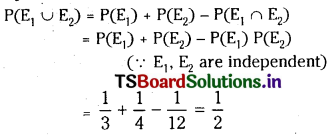
Question 17.
A and B toss a coin 50 times each simultaneously. Find the probability that both of the in will not get tails at the same toss.
Solution:
Let E be the event that A and B both will not get tails at the same toss. In each toss we have the following four choices:
(i) A: Head, B: Head
(ii) A: Head, B: Tail
(iii) A: Tail, B: Head
(iv) A: Tail. B:Tail
Since there are 50 trails, the total number of choices is 450
But out of the four choices listed above, only (i), (ii) and (ii) are favourable to the occurrence of the required event E.
∴ P(E)=\(\frac{3^{50}}{4^{50}}=\left(\frac{3}{4}\right)^{50}\)
Question 18.
If A and B are independent events of a random experiment, show that Ac and W are also independent
Solution:
If A and B are independent, then
P(A∩B) = P(A) P(B).
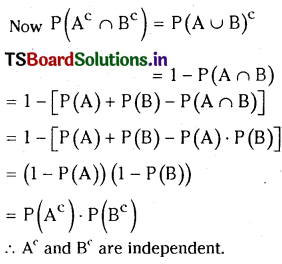
Question 19.
Three boxes B1, B2 and B3 contain balls with different colours as shown below:
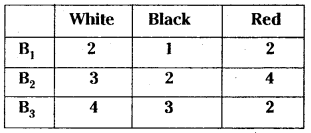
A die is thrown, B1 is chosen if either 1 or 2 turns up. B2 is chosen if 3 or 4 tunis up and B3 is chosen if 5 or 6 turns up. Having chosen a box in this way, a ball is chosen at random from this box. If the ball drawn is found to be red, find the probability that ills drawn from box B2.
Solution:
Let E1 be the event of choosing the box Bi and P(Ei) be the probability of choosing the box Bi. i = 1, 2. 3. Then
P(E1) = P(E2) = P(E3) = \(\frac{2}{6}=\frac{1}{3}\)
P(R|E1) = \(\frac{2}{5}\), P(R|E2) =\(\frac{4}{9}\), P(R|E3) = \(\frac{2}{9}\)
We have to find the probability P(E2| R).
By Bayes theorem P(E2| R)
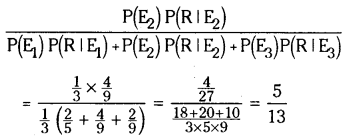
Note: In all the above problems the sample space is finite. In the following case, the sample space is countably infinite.
![]()
Question 20.
An urn contains w white balls and b black balls. Two players Q and R alternatively draw a ball with replacement from time urn. The player that draws a white ball first wins the game. If Q begins the game, find the probability of his minimizing the game.
Solution:
Let W denote the event of drawing a white ball in any draw and B that of a black ball.
